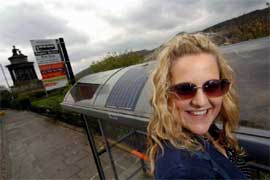 |
|
| Solar panels have been successfully tested at a handful of bus shelters, including this one on Regent Road. Picture: Gareth Easton |
THE city’s bus shelters may not seem the sunniest of places when the wind’s blowing, the rain’s pouring down and the bus is taking an age to arrive.
But, despite the apparent disadvantages of the Edinburgh climate, solar power is to be used to light up more than 100 of the city’s busiest bus stops.
The move – which will see the bus stops light up when passengers walk in after dark – follows successful trials of the new technology at a handful of shelters across the Capital.
The city council hopes the move will make passengers feel safer at night and deter vandals, as well as making it easier to read timetables.
Although the solar panels will cost £220,000 to install, it will prove cheaper in the long-run than laying electricity cables to the shelters.
The council hopes to eventually have solar panels – which are installed on the shelter’s roofs – on most of the local authority’s 1100 shelters.
Initially, more than 100 bus stops along the A8 and between Leith and Straiton are set to get solar-powered lighting.
Councillors are expected to agree next week to spend cash awarded to the city by SESTRAN, the regional transport partnership for south-east Scotland, on the project.
A council spokeswoman said: “The roll-out of solar power to 110 bus shelters across the city highlights the council’s commitment to using sustainable resources.
“In the past the difficulty and high cost of connecting to a mains electrical supply has restricted the use of lighting within bus shelters.
“The fast-developing technology of solar-power systems makes it possible to improve lighting levels at most bus stops.”
The bus shelters are lit up at night using energy stored by the south-facing solar panels fixed to the shelters’ roofs.
It means there is low-level lighting on throughout the night, while an infrared sensor fully activates the light when it detects someone nearby – and remains on until shortly after the passenger has left the immediate area.
Of Edinburgh’s 1600 bus shelters, only the 500 owned and maintained by advertising company Adshel, are currently equipped with lights – which are switched on at the same time as street lighting.
Technology company Carmanah is responsible for designing the equipment used in the Capital. Vice President Richard Sowter said: “Edinburgh City Council’s pioneering solar shelter contract uses solar energy at its finest, generating power where you need it to provide quality lighting at bus shelters for passengers comfort and safety.”
The 11 solar-powered shelters that have been on trial in Edinburgh are dotted around the city at locations including Regent Road, Dalkeith Road, Old Dalkeith Road, Craigmillar Park and on the A8 near Edinburgh Airport.
The Capital already boasts hundreds of solar-powered parking meters in the city centre, which allow drivers to pay by mobile phone.
The first solar-powered bus shelter in the UK went on trial in North Lanarkshire in 2003.
Others have since followed in Leicester, Birmingham, Plymouth and Southampton.
City development director Andrew Holmes said: “The department is also looking at the use of solar power to illuminate bus stops where no shelter is provided and is developing prototypes with the bus-shelter contractor.”
THE FACTS
The bus shelters’ solar panels harnesses the sun’s energy throughout daylight and store the energy for nighttime.
The sun does not need to be visible for the panels to work, and enough energy will reach the in-built rechargeable batteries on even the most miserable of winter days.
At dusk, a hi-tech “energy management system” releases the stored-up energy and uses it to power high-intensity LEDs – light-emitting diodes.
The technology contains no moving parts and releases no emissions. The LEDs are highly efficient, vandal resistant and have an expected lifetime of 100,000 hours.
A low level of lighting is emitted all night, and when an infrared sensor detects someone nearby, the light fully activates and remains on until shortly after the passenger has left the immediate area.